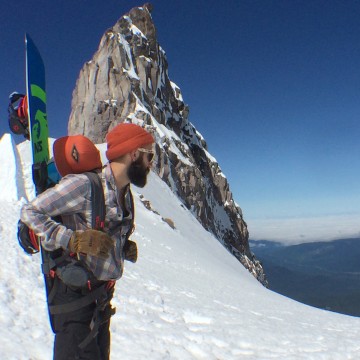A Guide to Backcountry Skiing and Snowboarding
Saturday, November 22, 2014

Jeff Acciaioli
If this sounds familiar, it might be time to earn your turns and head out of bounds. The backcountry, beautiful and serene, is a place where you can get away from crowded resorts, lift lines, and find the best powder lines. It’s a place where you can find solace and connect with nature. For some, this is nirvana – but be aware that this bliss can bring danger as well.
Crumbling cornices, avalanches, tree wells, exposed rocks, and whiteout storms are just some of the threats that nature poses to the backcountry explorer. Having the right equipment and proper training is vital if you plan to play with the ever-shifting snowscape. Accessing the backcountry can be incredibly rewarding, but it can be dangerous. There’s no need to be scared, just prepared. If you feel like you’re ready, here are seven tips to get you started:
1) Research
Here’s an admission: I love reading mountaineering and avalanche survival books. Really. It’s exciting stuff and incredibly useful knowledge for getting you and your buds out onto some untouched terrain. One of my favorite books is Climbing the Cascade Volcanoes by Jeffrey L. Smoot, which is part of the excellent “Regional Rock Climbing Series” published by FalconGuides.
I also recommend checking out the Avalanche Awareness section on the Mt. Hood Meadows’ website. Not only will it break down the basics, but it provides a gateway to useful websites like Avalanche.org, which has a great online avalanche safety tutorial.
When you’re ready for some action, taking an avalanche awareness class is recommended as well. The Northwest Avalanche Center (NWAC) offers them in Portland throughout the year as a public service.
2) Choosing Your Adventure
If you feel like you’re ready to branch out from your local resort, plan a day trip in a familiar location. For starters, do some research and choose a route that has been previously explored. A documented route will provide pro tips such as gear suggestions, skill level, route length, hazards, and the best season for that hike.
A few of my local favorites are Illumination Rock, which is about 4000 ft. above the Timberline parking lot, and Bowls 1 and 2 at Mt. Hood Meadows. When hiking near a resort, make sure to read their hiking regulations. For other great routes in the Pacific Northwest check out one of my favorite books Backcountry Ski and Snowboard Routes: Oregon by Christopher Van Tilburg.
3) Pick a Partner
If you’re stuck in a tree well, buried under an avalanche or just flat out injured, the chances of saving yourself are pretty slim. Remember the advice from mom, “Always swim with a buddy”? It still works. You never know when you’re going to need to help dig somebody out, or carry somebody to safety. With that said, you’re going to want go with someone you trust. Pick a partner that also understands the risks and safety routines of backcountry exploration. Not only will the buddy system save your lives, but hiking and shredding with a friend is way more fun. (Plus, mom is always right.)
4) Gear Up
Once you figure out where you’re going, and what sort of obstacles you may encounter, make a checklist for your gear. These are the basics: a backpack, aluminum shovel, collapsible probe, avalanche beacon, crampons, ice axe, eye protection, helmet, GPS, compass and a first-aid kit as well as food and water. But depending on your adventure, you may need more or less. Do your homework before you go out and play – and don’t forget that you will need to know how to use all of your equipment before you leave home. Practice. And then practice some more.
5) Layer Up
On the outside, a water and wind resistant shell will protect you from the elements. Wear synthetic or wool base layers that wick water away from your body. Avoid cotton! Cotton absorbs water, which makes it difficult for your body to regulate its temperature. If you have never heard this before, let me be the first to tell you that “cotton kills.” In the backcountry, the weather can change rapidly, wearing the proper layers will help you adapt while keeping you warm and dry.
6) Check Weather and Snow Conditions Carefully
Checking weather conditions means more than glancing at an app the night before you go. Weather conditions change minute by minute. Bookmark the National Oceanic and Atmospheric Administration’s (NOAA) website which has watches, warnings and advisories for Oregon that are updated every two to three minutes and the website for the Central Oregon Avalanche Association which has a terrific list of weather information.
7) Checking In and Out
Call your parents, text your roommate, or brag about what you’re about to do on Facebook. When you head out, make sure someone that isn’t in your group knows where you’re going, when you are leaving, and when you plan to return. When you get back, check in with a post, another text and call your parents so that everybody knows you made it safe.
Each time you enter the backcountry you will gain experience and new skills. Start small, and build from there. While exploring, if you have any doubts, stop and assess the situation, if you still have doubts, remember that it is ok and probably best to turn around. There’s no point in making it to the top, if you don’t make it home. If you have any questions, don’t hesitate to contact us over at Daddies Board Shop at (503)281-5123 or stop by our shop in NE Portland. We will answer them the best we can.
Jeff Acciaioli is the Snow Buyer for Daddies Board Shop. When Jeff doesn't show up to work, it’s safe to assume that he is somewhere in the mountains.




 Delivered Free Every
Delivered Free Every
Follow us on Pinterest Google + Facebook Twitter See It Read It